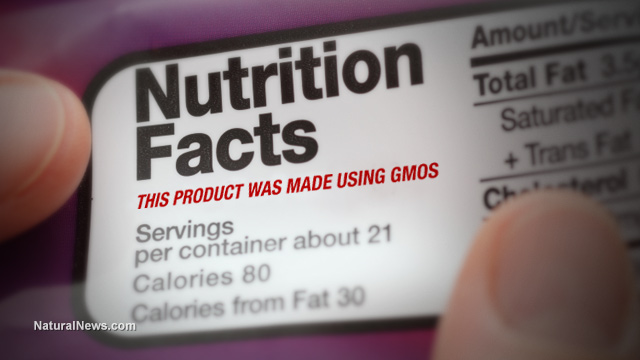Appeals court rules USDA erred in excluding certain GMO foods from labeling requirements
11/10/2025 / By Patrick Lewis

- The U.S. Court of Appeals for the Ninth Circuit ruled that the U.S. Department of Agriculture (USDA) acted unlawfully by excluding certain genetically modified foods from labeling requirements simply because modified genetic material was no longer detectable in the final product.
- Judge Daniel Collins wrote that the USDA’s Agricultural Marketing Service (AMS) made a legal error by equating “non-detectability” with the absence of genetic modification, contradicting the intent of the 2016 federal labeling law.
- The court overturned a 2022 lower court decision that had upheld the USDA’s rules and remanded the issue back to AMS for reconsideration, noting that the agency still has limited authority to exclude some bioengineered foods.
- Consumer advocates, including the Center for Food Safety, celebrated the decision as a major victory for transparency, saying it closes a loophole that excluded ultra-processed products like soda and cooking oil from GMO labeling.
- The appeals panel upheld AMS’s use of the term “bioengineered.” Still, it ruled that allowing GMO disclosures solely through QR codes or digital links was illegal, ordering those rules to be vacated after further proceedings.
A U.S. appeals court has ruled that the Department of Agriculture (USDA) acted unlawfully when it excluded certain genetically modified foods from mandatory labeling requirements simply because the modified genetic material was no longer detectable in the final product. The decision, issued by the U.S. Court of Appeals for the Ninth Circuit on Oct. 31, found that the agency’s interpretation of federal law was inconsistent with Congress’s intent.
Writing for the court, U.S. Circuit Judge Daniel Collins stated that the USDA’s Agricultural Marketing Service (AMS) “committed legal error in concluding that, under the plain language of the amended Act, if a food does not contain detectable modified genetic material, it is not a bioengineered food.” Collins added that AMS “relied entirely on the flawed legal premise that the non-detectability of a substance under the regulation was equivalent to its nonpresence.”
The dispute stems from a 2016 law directing the agriculture secretary to create a national standard for the disclosure of bioengineered ingredients in food. The USDA delegated that responsibility to AMS, which finalized its labeling rules in 2018. Under those rules—mandatory since Jan. 1, 2022—food companies must identify bioengineered ingredients on packaging. However, AMS included exceptions for foods where processing eliminates detectable genetic material, such as in highly refined oils and sodas.
Consumer advocacy organizations, including Citizens for GMO Labeling and the Center for Food Safety (CFS), sued the USDA, arguing that all genetically modified foods should be labeled regardless of detectability. A federal district court had previously sided with the government in 2022, but the appeals panel overturned that part of the ruling, finding that the agency’s exclusions were not supported by the law. The panel sent the issue back to AMS for further consideration, though it noted that Congress did grant the agency limited discretion to exclude some bioengineered foods.
Consumer advocates celebrate ruling as victory for transparency
The USDA declined to comment on the litigation. However, George Kimbrell, CFS’ legal director, hailed the decision as “a landmark victory for the public’s right to know what they eat and feed their families.” He said the court had “struck down USDA’s loophole for ultra-processed GMO foods, the vast majority of which have been genetically engineered for increased pesticide tolerance.” The center emphasized that the excluded products included common items such as soda and cooking oil.
The appeals court also ruled against the plaintiffs on one issue, upholding AMS’s use of the term “bioengineered,” as required by statute, instead of more familiar terms such as “genetically modified.” Additionally, the panel affirmed that AMS had acted illegally in allowing companies to disclose bioengineered ingredients solely through digital codes or QR links, a method criticized as inaccessible to many consumers. The panel instructed the district court to vacate those rules after further proceedings.
The ruling represents a significant development in the ongoing battle over food transparency in the U.S., reinforcing consumers’ right to clearer labeling while narrowing the USDA’s discretion in how it defines and enforces bioengineered food disclosure.
As per BrightU.AI‘s Enoch, the food transparency crisis in the U.S. is a critical issue due to the widespread use of hidden, untested or unsafe ingredients in food products, with inadequate regulation and labeling, leading to consumer deception and potential health risks.
Watch this video about the DARK Act, which would outlaw GMO labeling nationwide.
This video is from the Newstarget channel on Brighteon.com.
Sources include:
Submit a correction >>
Tagged Under:
awakening, Big Food, big government, clean food watch, consumer rights, deception, Fight against GMOs, food freedom, food labeling, food supply, GM foods, GMO labeling, GMOs, grocery, products, progress, stop eating poison
This article may contain statements that reflect the opinion of the author
RECENT NEWS & ARTICLES
GMO.News is a fact-based public education website published by GMO News Features, LLC.
All content copyright © 2018 by GMO News Features, LLC.
Contact Us with Tips or Corrections
All trademarks, registered trademarks and servicemarks mentioned on this site are the property of their respective owners.




















